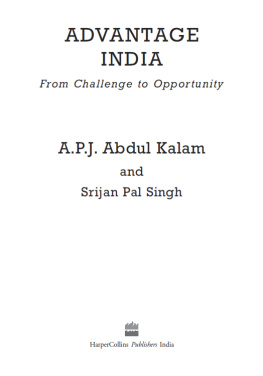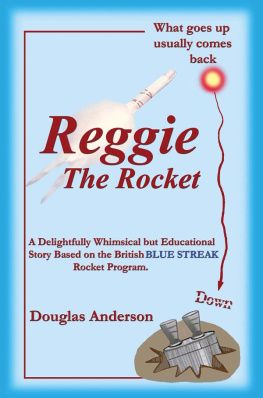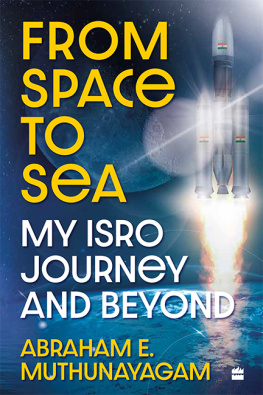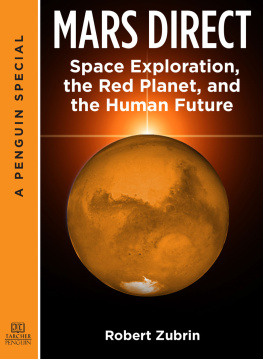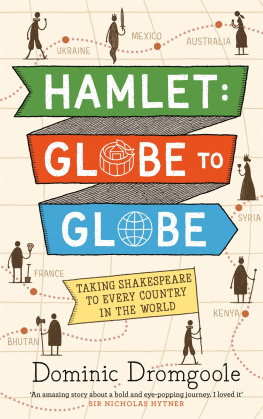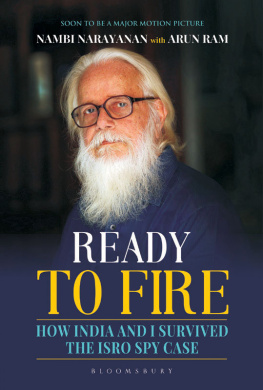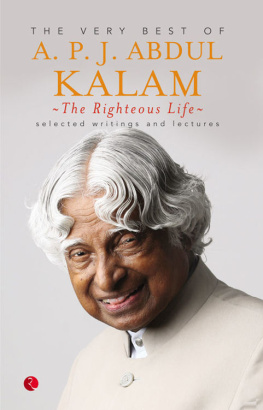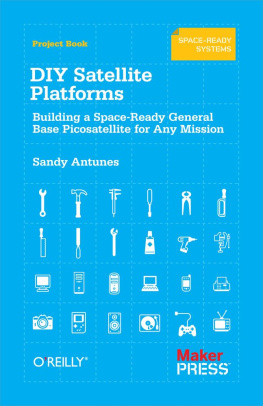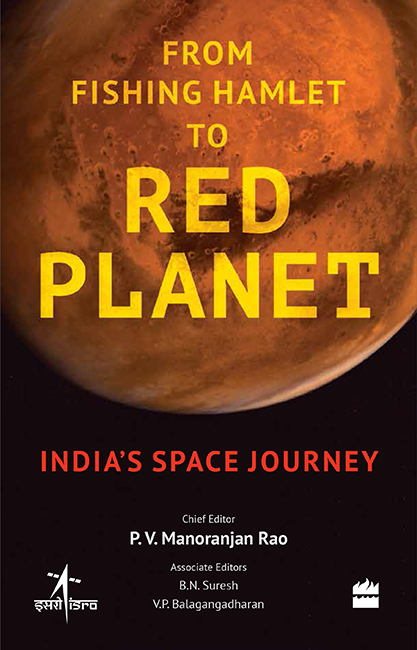
From Fishing Hamlet to Red Planet
Indias Space Journey
Chief Editor
P.V. MANORANJAN RAO
Associate Editors
B.N. SURESH
V.P. BALAGANGADHARAN

HarperCollins Publishers India
Contributors

Jacques Blamont
Vikram A. Sarabhai
M.G.K. Menon
E.V. Chitnis
Yash Pal
Satish Dhawan
R. Aravamudan
P.V. Manoranjan Rao
S.C. Gupta
A.P.J. Abdul Kalam
N. Narayanamoorthy
R.V. Perumal
S. Ramakrishnan
V.N. Krishnamurthy
Vasant R. Gowariker
A.E. Muthunayagam
N. Vedachalam
U.R. Rao
R.M. Vasagam
Pramod Kale
S. Kalyana Raman
P.S. Goel
George Joseph
K. Narayana
S.K. Shivakumar
V. Jayaraman
P.R. Pisharoty
M.S. Swaminathan
Ranganath Navalgund
Shailesh Nayak
Mukund Kadursrinivas Rao
Arnold W. Frutkin
B.S. Bhatia
N. Prahlad Rao
Suresh V. Kibe
K.R. Sridhara Murthi
M.N. Sathyanarayan
M.Y.S. Prasad
M. Annadurai
V. Adimurthy
J.N. Goswami
B.N. Suresh
A.S. Kiran Kumar
S. Arunan
V. Narayanan
S. Somanath
S. Unnikrishnan Nair
K. Kasturirangan
G. Madhavan Nair
K. Radhakrishnan
HJB
VAS
Contents


The Indian space programme was launched by Dr Vikram Sarabhai and Dr Homi Bhabha with support from Pandit Jawaharlal Nehru, the first Prime Minister of independent India.
On 21 November 1963 the first rocket announcing the birth of our space programme took off from Thumba a fishing hamlet near Trivandrum (now Thiruvananthapuram), the capital of Kerala. For this launch everything came from abroad: the rocket, the payload, the radar, the computer and the helicopter literally everything. Fifty years later, on 5 November 2013, when ISRO launched its Mars Orbiter Mission (MOM) from the Satish Dhawan Space Centre, Sriharikota in Andhra Pradesh, everything came from within the country. And about ten months later, on 24 September 2014, we succeeded in inserting MOM into an orbit around Mars, thus creating history. India became the first country in the world to put a satellite around the Red Planet in the very first attempt. By any standards, this is a stupendous growth in capability.
This volume has contributions from almost all the pioneers of our space programme. We have here around fifty articles of varying lengths, technical contents and styles, and they cover the entire range of activities of ISRO. In addition, it has contributions from some of the current generation of scientists and engineers who are leading our space programme. It also has brief contributions from two of the world-renowned scientists outside ISRO: Prof. Jacques Blamont, pioneer of French Space Programme and Prof. M.S. Swaminathan, pioneer of Indian Green Revolution.
Our focus, right from the days of Sarabhai, has been and continues to be harnessing space technology for national development. The technology has been effectively used for disaster risk reduction, monitoring resources, planning, development, tele-education, governance and rekindling interest in science and technology among students through space science missions. The Mars Obiter and Chandrayaan-1 missions have also caught the attention of the global community for the innovative approaches used in making the missions affordable.
This compendium of articles, interviews and reproductions edited by Dr P.V. Manoranjan Rao, assisted by Dr B.N. Suresh and Shri V.P. Balagangadharan, former scientists of ISRO, tells the incredible story of how ISRO did this. The title of the book tells it all. I congratulate the editors for this mammoth effort.
Scientists and engineers of ISRO would be greatly benefitted by reading this book as it links them to their organisations roots. Indeed, this publication deserves wide readership outside ISRO as well. Anyone interested in knowing the history of space programme in India would find authentic information in this book.
I wish the publication all success and hope it will find its way to libraries of academic institutions and bookshelves of our countrymen.
| Bengaluru | A.S. Kiran Kumar |
| Chairman, ISRO |
| 17 May 2015 |

We started working on this compendium in September 2012, at the request of Dr K. Radhakrishnan, former Chairman of ISRO. Our intention was to publish it in November 2013 to commemorate the fiftieth anniversary of the birth of the Indian space programme. (This is the reason why some of the articles in this volume refer to the fiftieth anniversary.) But we soon realised we could not be ready for the November 2013 release. There were two main reasons for this: (1) it took us a fairly long time to get all the articles we had solicited and (2) ISRO was breaking new ground in planetary exploration. It did not seem proper to publish a compendium without these historic events. The result is this book titled: From Fishing Hamlet to Red Planet.
We certainly wanted to include photographs but then this volume would become too unwieldy to be comfortable. But not to include photographs is not a pleasant option. Thus we have plans to bring out a second volume that would be a visual complement to the present one. For this purpose we have already collected a good number of photographs, some of them of vintage value. We intend to make the text of the second volume really popular so that even a lay reader would get a good idea of what ISRO has achieved over the years, while appreciating the striking visuals for which space technology is so famous! The reader would also get a glimpse of the pioneers who made it all happen.
On the other hand, this compendium is a healthy mix of popular, semi-popular and somewhat technical articles of varying lengths and different styles. While editing, we took care to retain the original flavour of the authors style. There was a suggestion that all the articles should be edited and if necessary rewritten by a professional in a popular journalistic style, to sustain reader interest. We did not find this suggestion desirable.
We did try to persuade the contributors to keep their articles short and simple. But some contributors found the subject matter too complex to keep it short. The reader will also find a few things being repeated in different articles. We retained the repetitions, especially in essays dealing with applications, so that each article reads like a stand-alone piece by itself. This is deliberate and not an editorial oversight! No doubt, this approach has made the volume a bit bulky but we hope the reader would appreciate the pains taken by the individual contributors.
We have included a special write-up titled An Overview which provides the needed background for the reader to appreciate the underlying unity of theme, viz., how ISRO mastered various technologies to make our country a spacefaring nation. More importantly, these essays give the reader an idea of how ISRO harnessed those technologies for national development.
This is a compendium of interviews, reproductions, reminiscences and contributed articles representing three generations of ISRO professionals: the first generation of visionaries and pioneers who laid the foundation and built the superstructure called ISRO, the second generation that struggled to design and develop operational satellites and launch vehicles, and the third generation that is now literally reaching for the stars and taking us into interplanetary exploration! This, we believe, is the unique feature of this compendium.
Next page

